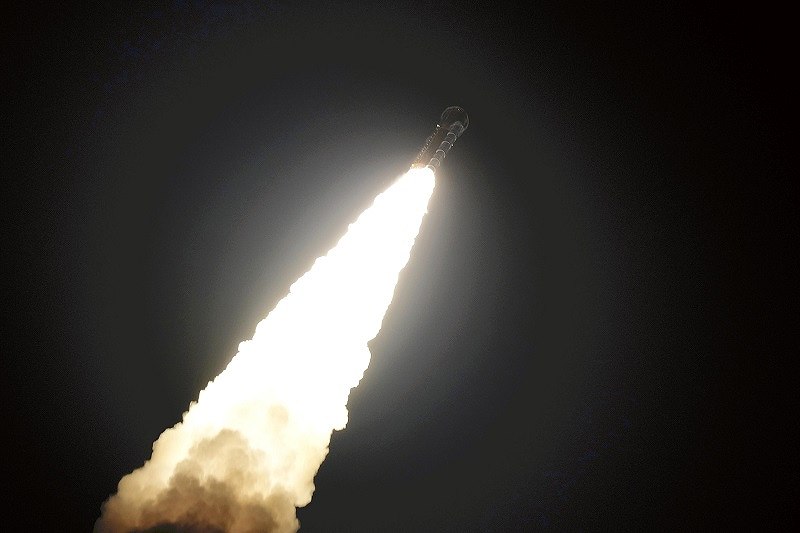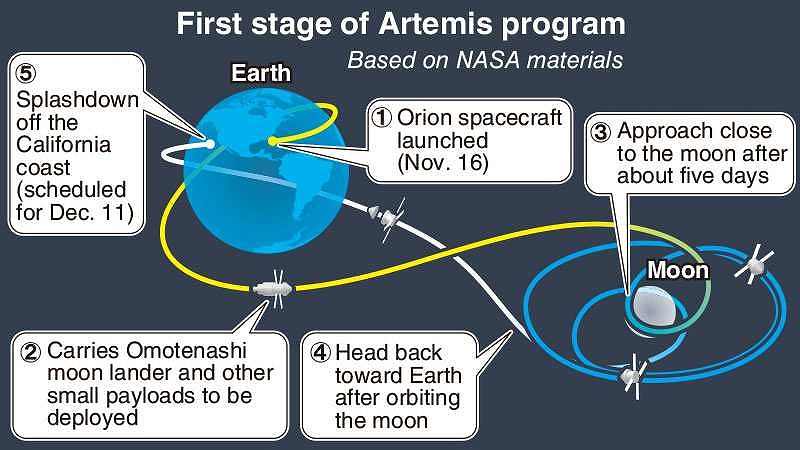
The Space Launch System rocket, with two Japanese payloads aboard, soars into the sky after blasting off from the Kennedy Space Center in Florida on Wednesday.
18:07 JST, November 17, 2022
KENNEDY SPACE CENTER, Fla. — NASA’s huge Space Launch System rocket blasted off Wednesday with two Japanese payloads aboard, opening a new chapter in moon exploration and offering a chance for Japan to showcase its technologies and make its presence felt among other nations involved in the project.
The Orion spacecraft fitted atop the rocket will separate from it in space and then spend about five days flying toward the moon. After orbiting the moon, Orion will head back to Earth and is scheduled to splash down off the California coast on Dec. 11.
The launch is part of the Artemis program, which plans to have a manned mission orbit the moon in 2024 and have astronauts back on the lunar surface in 2025 or later. The U.S. National Aeronautics and Space Administration plans to continue crewed flights to the moon about once a year from 2027 to build up experience and time spent on the surface.
However, there likely will be difficulties along the way. The current unmanned test flight comes almost five years after the initial target date, and a spate of problems, including engine trouble and fuel leaks, emerged before the launch.
The program’s cost is also causing furrowed brows. Each launch of the Space Launch System bearing the Orion spacecraft is estimated to cost $4.1 billion (about ¥570 billion). Even in the United States, there is strong criticism that such astronomical expenditures are “not sustainable.”
Aboard the current Orion mission are two Japanese payloads — the Japan Aerospace Exploration Agency’s Omotenashi, which aims to become the nation’s first moon lander, and Equuleus, a small probe that will fly to the moon’s far side.
Omotenashi, which would be the world’s smallest moon lander, is meant to touch down at a speed of about 180 kph in an area near the moon’s equator on Monday or Tuesday Japan time. The mission will be considered a success if the lander, after arriving on the lunar surface, transmits radio waves that reach Earth.
JAXA estimates there is a 60% chance of success. Omotenashi has cost between ¥700 million and ¥800 million, excluding personnel expenses.
“This small probe has been relatively low-cost,” said Tatsuaki Hashimoto, a professor at JAXA and head of the Omotenashi development team. “If this succeeds, the hurdles to space exploration will be lowered.”
Japan’s participation in the Artemis program will also include supplying the HTV-X unmanned cargo transport vehicle for the planned Gateway space station that will orbit the moon and is scheduled to be completed in about 2028. JAXA hopes to have a Japanese astronaut set foot on the moon for the first time in the latter half of the 2020s, so it is possible that one of the new astronauts currently being selected could achieve that milestone.
Wakayama University Prof. Hiroaki Akiyama, an expert on space policy, said: “A new era of mankind aiming for the moon has started. This will be a golden opportunity for Japan to also showcase its excellent technological capabilities.”
Lander signals ‘unstable’
18:07 JST, November 17, 2022

Communication with the Omotenashi moon lander has become “unstable” as it travels through space on its trailblazing mission, the Japan Aerospace Exploration Agency said Thursday.
A problem apparently occurred with the lander’s attitude control and its solar cells were not facing the sun, so its battery was at risk of running out of power.
JAXA has transmitted a signal in an attempt to adjust the lander’s attitude and rectify the situation.
Omotenashi blasted off Wednesday afternoon Japan time onboard the U.S. Space Launch System rocket and was deployed into space that evening. Although JAXA later confirmed the lander had power, the battery reportedly was not charging. Consequently, a majority of the lander’s equipment, including its transponder, reportedly did not start up properly.
JAXA has confirmed that the Equuleus, a small probe that was also launched with the Omotenashi, was continuing to fly as planned. It will take about 18 months to reach what is called a Lagrange point, a location in space behind the moon from the Earth where a balance of gravitational forces will allow it to remain in place.
"Science & Nature" POPULAR ARTICLE
-

Genome Study Reveals Milestone in History of Cat Domestication
-

Big Leap in Quest to Get to Bottom of Climate Ice Mystery
-

Security Camera Footage Vulnerable to Outside Access; Investigation Finds 3,000 Pieces Exposed Online
-

Japan Set to Participate in EU’s R&D Framework, Aims to Boost Cooperation in Tech, Energy
-

Paws on Parade: Nairobi’s Dogs Dazzle at ‘Pawchella’
JN ACCESS RANKING
-

Tokyo Economic Security Forum to Hold Inaugural Meeting Amid Tense Global Environment
-

Keidanren Chairman Yoshinobu Tsutsui Visits Kashiwazaki-Kariwa Nuclear Power Plant; Inspects New Emergency Safety System
-

Imports of Rare Earths from China Facing Delays, May Be Caused by Deterioration of Japan-China Relations
-

University of Tokyo Professor Discusses Japanese Economic Security in Interview Ahead of Forum
-

Japan Pulls out of Vietnam Nuclear Project, Complicating Hanoi’s Power Plans






















